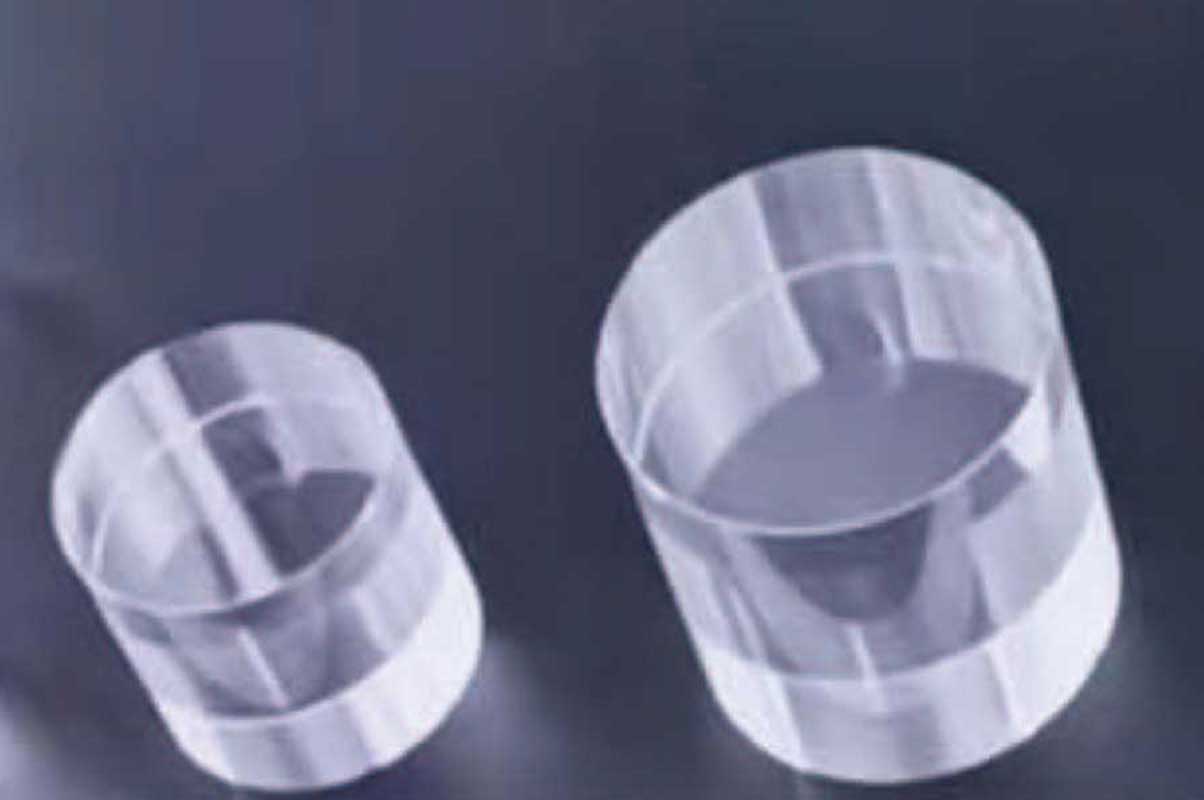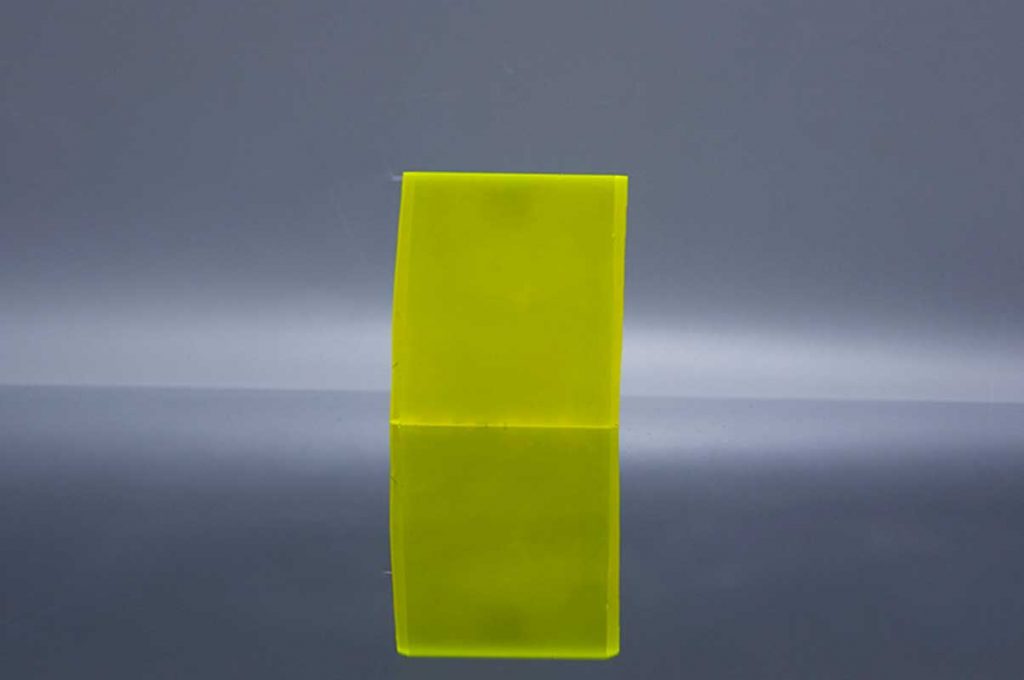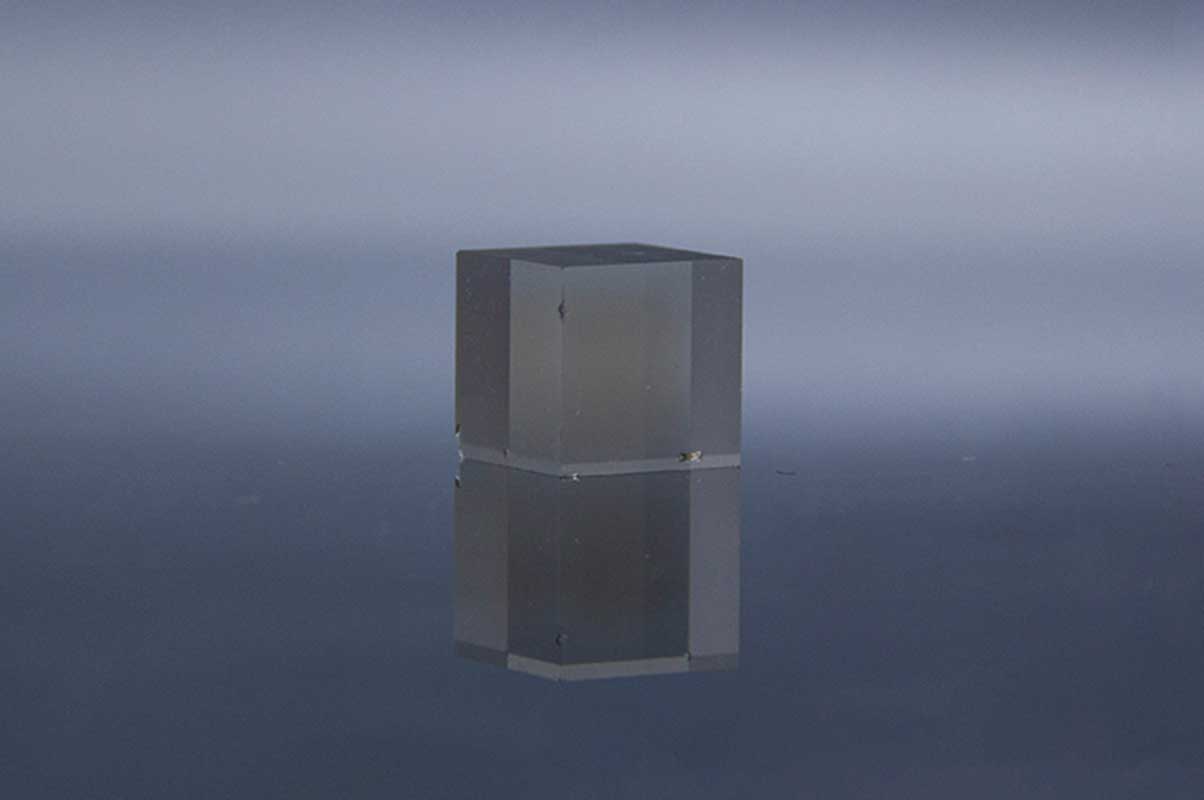PET
Positron emission tomography (PET) is one of the most important imaging techniques in nuclear medicine, which plays an irreplaceable role in biomedical research and clinical diagnosis. PET technology is a three-dimensional imaging nondestructive testing technique that uses a positron-emitting radioisotope-labeled compound to inject into the organism to measure their spatial distribution and time characteristics in vitro. The detector is the key component of the PET system, which is mainly responsible for detecting annihilated photons and converting the detected cases into electrical signals. The geometrical design of the system alongside the characteristics of the individual PET detector modules contributes to the overall performance of the scanner. The detector performance is mainly influenced by the characteristics of the photo-detector and the scintillation crystal. Scintillation crystals are widely used in PET mainly because of its properties: high density, high light yield, low decay time and absence of hygroscopicity.
The performance of a PET scanner is directly affected by many design factors, including the geometry of the scanner, the detector modules, read-out electronics, data acquisition and processing, and image reconstruction algorithm. Currently, the majority of PET optical converters use inorganic scintillation crystals, which convert gamma photons of 511 keV generated by positron annihilation into low-energy photons suitable for photomultiplier detection and realize photon number amplification. The selection of scintillation crystal by PET mainly depends on the following four points:
- In order to minimize the radiation dose received by the subjects and shorten the imaging time, the crystal is required to detect 511 keV gamma photons with high detection efficiency or blocking ability, so the crystal with relatively high effective atomic number and density is preferred.
- In order to make the PET scanner work in the state of high count rate, the time count loss is required to be as small as possible, so the crystal should have a relatively short luminescence decay time; Moreover, if the luminescence attenuation time of the crystal is short, the coincidence time window can be reduced and the influence of random coincidence can be reduced.
- In order to minimize the statistical errors and obtain good energy resolution and position resolution, the light yield of the crystal should be as high as possible.
- In order to cooperate with the photomultiplier tube, the scintillation light wavelength of the crystal should range from 380 to 440 nm.
According to the reports, many crystals have been proven to act as scintillation crystals which can be applied in PET. In the PET system, one scintillation crystal or several different crystals cooperating are used as detector. At the moment, scintillation crystals that can be mass produced are: BGO、LSO、Ce:LYSO、Ce:GaGG、GSO、LuYAP.
The following figure shows the basic structure of the detector for the event circuit. The basic detection unit in the figure is a pair of photon detectors (PMT/APD/MPPC, etc) coupled with scintillation crystals. The electrical signal generated by photons received by the detector is transmitted to the preamplifier for signal amplification.Therefore, the scintillation crystal is required to have a higher light output and a shorter decay time.

Scintillation crystals used in PET
BGO
Features
- High density
- Short radiation length
- Large refractive index
- High detection efficiency
- High packing rate
- High braking force
Scintillators are attractive materials for PET detectors due to their high detection efficiency, large light fraction and relatively low cost. In the clinical field, there is a strong demand for cost-effective whole-body PET scanners with high sensitivity, which has facilitated research to implement BGO interaction depth (DOI) detectors. The peak emission wavelength of BGO is -480 nm, which matches the spectral response of the photomultiplier tube very well. BGO has an effective atomic number of 75 and a density of 7.1g/cm3, which can improve the efficiency of detecting 511 keV γ photons by minimizing the radiation dose received by the subject and shortening the imaging time. The radiation length of the BGO is 1.12cm, which facilitates the production of compact detectors or probe components, improving spatial resolution and saving costs.
BGO crystal has good piezoelectric properties, high photoelectric conversion efficiency and stable thermal properties. PET detectors based on BGO crystals typically have filling rates higher than 90%. High fill rate has always been one of the design goals to achieve maximum detection sensitivity. At present, many research institutions cooperate with BGO to use other scintillation crystals, which can maximize the advantages of BGO and overcome its disadvantages of low output light yield and long decay time. In addition, BGO crystal has no afterglow, no dissociation surface, strong resistance to irradiation, stable chemical properties, easy to process and maintain.
| BGO | Time generation [ns] | Density (g/cm3) | Effective atomic number |
| Ref[1] | 1.5 | 7.13 | 75 |
| Ref[2] | / | 7.13 | 75 |
| Ref[3] | 4.1 | 7.1 | 75 |
References
[1]MPPC Arrays in PET Detectors With LSO and BGO
[2] A DOI Detector With Crystal Scatter Identification Capability for High Sensitivity and High Spatial Resolution PET Imaging
[3] Performance Characteristics of BGO Detectors for a Low Cost Preclinical PET Scanner
Ce:LYSO
The design of positron emission tomography (PET) scanners is particularly challenging because it should not compromise high spatial resolution, high sensitivity, high count rates, and good energy and temporal resolution. At the detector level, scintillation crystal and photodetector are the two main and key devices, which are either composed of small pixel scintillation elements or large monolithic crystals. In both methods, the main goal is to achieve high spatial resolution, high sensitivity, high count rate performance, and good energy resolution and time resolution over the entire field of view (FOV). Ce:LYSO is the most widely used scintillator in PET. It has the characteristics of high density, high light yield, low decay time and no hygroscopicity.
Ce:LYSO is an LSO/YSO hybrid non-hygroscopic crystal with high density (7.1, 10% Y), high light output (26000 — 32000 pH/MeV), good energy resolution (~ 10%) and short decay time (40 ns). Its maximum emission wavelength is 420nm, which matches well with the photocathode of the photomultiplier tube. Recently, Ce:LYSO crystals coupled to SiPM have been widely used in PET systems. However, it is important to note that the intrinsic radiation from 176Lu results in gamma ray emission at 88, 202, and 307 keV, which results in a significant radiation background as the number of crystals in the PET scanner increases.
| Ce:LYSO (LuYSiO5) | Light output (ph/MeV) | Decay time (ns) | Emission wavelength (nm) | Density (g/cm3) | Energy resolution (%) |
| Ref[1] | 32*103 | 40 | 420 | 7.1 | 9 |
| Ref[2] | 32*103 | 40 | 420 | 7.1 | ~10 |
| Ref[3] | 26*103 | 40 | 420 | 7.1 | ~10 |
References
[1] Performance of FBK high-density SiPM technology coupled to Ce:LYSO and CeGAGG for TOF-PET
[2] Characterization of 1.2×1.2 mm2 silicon photomultipliers with Ce:LYSO, Ce:GAGG, and Pr:LuAG scintillation crystals as detector modules for positron emission tomography
[3] Luminescence Emission Properties of (Lu; Y)2SiO5Ce (LYSO:Ce) and (Lu; Y)AlO3Ce (LuYAPCe) Single Crystal Scintillators Under Medical Imaging Conditions
Ce:GAGG
Features
- High density
- Rapid scintillation reaction
- High yield
- Good intrinsic energy resolution
- High braking force
Positron emission tomography (PET) is a mature method to obtain biochemical function information of organs, which can be used for early detection of cancer and diagnosis of neurological diseases. Typical PET scanners have detectors consisting of thick scintillation crystals and photodetectors, such as photomultiplier tubes (PMT). These applications require scintillators with high light yield, good energy resolution, high effective atomic number, fast scintillation response and chemical stability.
Ce:GAGG scintillator is a new type of inorganic scintillator with a high optical yield of 46 000 photons = MeV. Its high light output is expected to improve the energy resolution of the DOI detector module and the accuracy of crystal identification. Ce:GAGG scintillator emits a yellowish light with an effective atomic number equal to 54.4. In addition, Ce:GAGG does not contain natural radioactivity, which may raise the minimum detectable activity limit of the system. Furthermore, when used in conjunction with SiPMs, the Ce:GAGG crystal has excellent timing resolution (below 200 ps), making it ideally suited for time-of-flight (ToF) PET applications. The average energy resolution of the Ce:GAGG array was 10.5% under 511 keV irradiation.
| Ce GAGG | Light output (ph/MeV) | Decay time (ns) | Emission wavelength (nm) | Density (g/cm3) | Energy resolution (%) |
| Ref[1] | 46*103 | 88 | 530 | 6.6 | 6.4 |
| Ref[2] | 55*103 | 97 | 520 | 6.7 | ~11 |
| Ref[3] | 46*103 | 88 | 520 | 6.6 | 10.6 |
References
[1] Performance of FBK high-density SiPM technology coupled to CeLYSO and CeGAGG for TOF-PET
[2] Characterization of 1.2×1.2 mm2 silicon photomultipliers with Ce LYSO, Ce GAGG, and Pr LuAG scintillation crystals as detector modules for positron emission tomography
[3] Development of prototype PET scanner using dual-sided readout DOI-PET modules
Ce:YAP
| Wavelength (Max. Emission) (nm) | 370 |
| Decay time (ns) | 28 |
| Light yield (Photons/kev) | 25 |
| Light output relative to Nal (TI) (%) | 60-70 |
| Refractive index | 1.95@370nm |
Ce:YAP (Yttrium aluminum olivine doped with cerium) has been shown to be an ideal candidate for PET (positron emission tomography) small animals. Its fast flicker, good light output, high density and excellent physical properties allow long, thin crystals to grow. These detectors are placed in bundles and optically coupled to position-sensitive readings, resulting in promising results. The main drawback of the Ce:YAP human PET application is the low electrical yield (~ 4%) at 511 keV time.
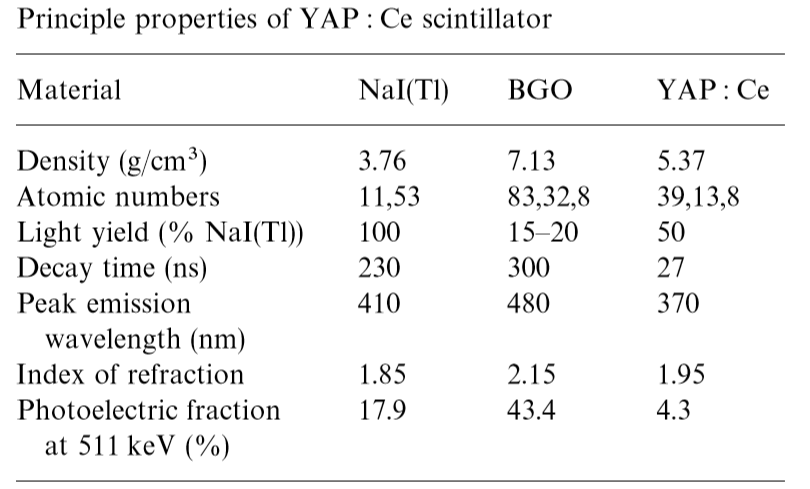
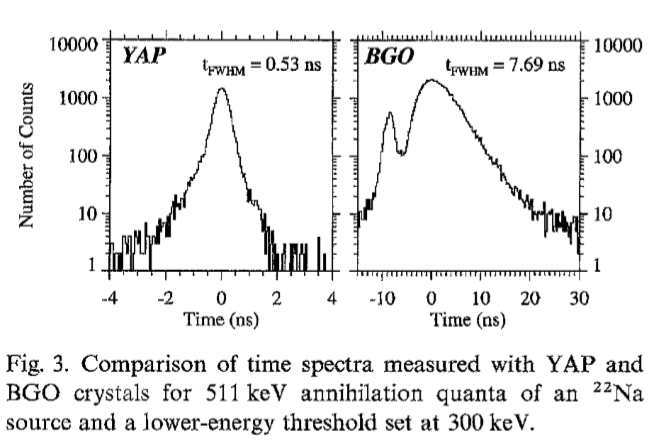
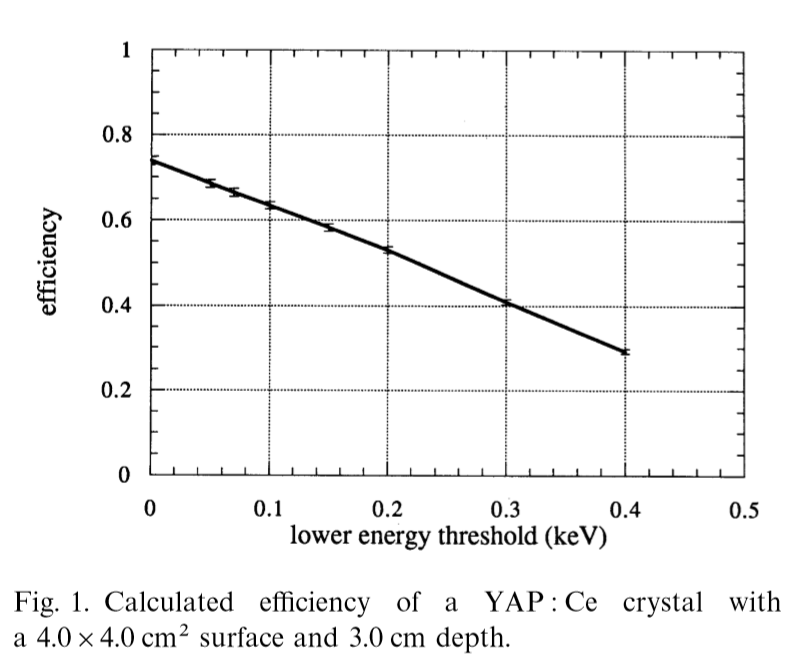

References
[1] High spatial resolution small animal YAP-PET
[2] Comparison of YAP and BGO for high-resolution PET detectors
[3] YAP-PET:first results of a small animal Positron Emission Tomograph based on YAP:Ce finger crystals
